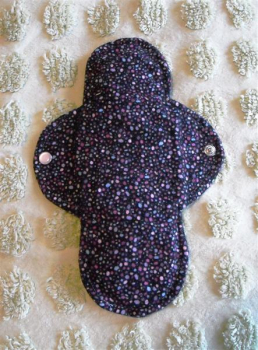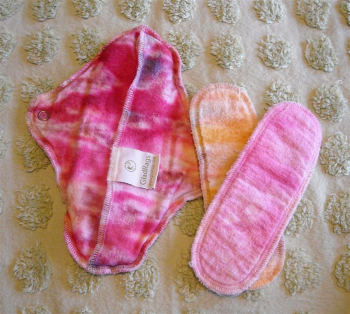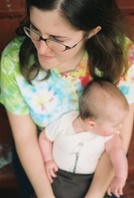
Drop the disposables: Sanitary pads
 Have a happy period.
Have a happy period.
If you've got television,
you've most
likely seen the Always commercial telling you how their plastic pads
are going to make your life easier, fresher, and yes, happier. The truth is, plastic
disposable pads aren't all that great--they're
full of all sorts of chemicals, very pricey and make weird noises in
public restrooms. They're also totally not breathable and they're
boring. Yup, I said boring.
Cloth pads make sense in
many ways. They're a much greener
choice--no weird gels to soak up exponential amounts of Aunty Flo, no
pads piling up in your local landfill. They're highly breathable
and I
no longer experience the grown-up diaper rash that I had with plastic
pads. Some women find their periods are shorter and lighter with
cloth
pads, and this has been true for me. Like other cloth items such
as
napkins and diapers, you buy or make them once and use them for
years.
You can even use them postpartum. For less than $200, you can
have
menstrual protection to last five years or more.
Now to the unboring
part--cloth pads come in a myriad of colors.
There are  many options on the internet,
but one of my favorites are
GladRags. They use fun batiks and florals. There's nothing
more
cheery than pulling out a bright and soft flannel pad during a somewhat
challenging time of the month. There are countless patterns
available
online for making your own and you are only limited by your imagination
and local fabric store. All you need are some basic sewing skills
and
an $8 snap setter (if you're feeling fancy). Some women add PUL
to
their pads for extra waterproofing, but this does compromise
breathability, so it's your choice. In my experience, the PUL
isn't
really necessary if you just stay aware of your flow patterns.
many options on the internet,
but one of my favorites are
GladRags. They use fun batiks and florals. There's nothing
more
cheery than pulling out a bright and soft flannel pad during a somewhat
challenging time of the month. There are countless patterns
available
online for making your own and you are only limited by your imagination
and local fabric store. All you need are some basic sewing skills
and
an $8 snap setter (if you're feeling fancy). Some women add PUL
to
their pads for extra waterproofing, but this does compromise
breathability, so it's your choice. In my experience, the PUL
isn't
really necessary if you just stay aware of your flow patterns.
Most folks cringe at the
thought of washing cloth pads, but the technique is rather simple and
involves very little actual handling
of the pads. Some fabrics will stain, but I've had very little
issue
with this, especially from my GladRags. Just place used
pads in a
small bucket (perhaps with a lid) that contains cold water and a few
drops of tea tree oil or Dr. Bronner's. Change the rinse water
daily
and wash the pads as often as you need. When you go out, just
carry a
plastic bag or a neoprene
wet bag
to keep them till you get home to soak them. Stick them in the
washer,
do a cold rinse and then a warm wash. Be sure to avoid fabric
softeners, since they have waterproofing properties. That's
all.
Super simple.
Here are some on-line
resources for making your own cloth pads:
- Adahy's Cloth Pad Patterns
- Sew Green's Cloth Pads
- Jan Andrea on the Web--a great resource for many handmade goodies
- Reusable Menstrual Products--a comprehensive site for all reusable menstrual products, including cups and sponges
- Cloth pads on Etsy--because buying handmade
touches a real person

style="font-family: Bitstream Charter;">

Brandy seeks self-sufficiency on a little lot in town, tending her most sincere pumpkin patch and borrowing the neighbor's clothesline. She lives with her husband Mike and daughter Willow, both of whom love it when she knits for them. Check out Brandy's blog and her etsy shop (full of hand-made napkins and other goodies to help you ditch the disposables.)
| This post is part of our Drop the Disposables lunchtime series.
Read all of the entries: |
Want more in-depth information? Browse through our books.
Or explore more posts by date or by subject.
About us: Anna Hess and Mark Hamilton spent over a decade living self-sufficiently in the mountains of Virginia before moving north to start over from scratch in the foothills of Ohio. They've experimented with permaculture, no-till gardening, trailersteading, home-based microbusinesses and much more, writing about their adventures in both blogs and books.
Want to be notified when new comments are posted on this page? Click on the RSS button after you add a comment to subscribe to the comment feed, or simply check the box beside "email replies to me" while writing your comment.
- Remove comment
- Remove comment
- Remove comment
- Remove comment
